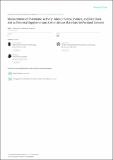| dc.contributor.author | Mboya, Hieronimi | |
| dc.contributor.author | King’ondu, Cecil | |
| dc.contributor.author | Njau, Karoli | |
| dc.contributor.author | Mrema, Alex | |
| dc.date.accessioned | 2019-07-24T10:38:52Z | |
| dc.date.available | 2019-07-24T10:38:52Z | |
| dc.date.issued | 2017-08-06 | |
| dc.identifier.uri | https://doi.org/10.1155/2017/6952645 | |
| dc.identifier.uri | http://dspace.nm-aist.ac.tz/handle/123456789/369 | |
| dc.description | Research Article published by Hindawi | en_US |
| dc.description.abstract | This work investigated the properties of scoria and pumice as supplementary cementitious materials (SCMs) for Portland cement
and compared to those of rice husk ash (RHA). X-ray fluorescence, X-ray diffraction, and pozzolanic activity index (PAI) tests
confirmed the suitability of these two materials as potential SCMs. Scoria and RHA samples achieved over 75% PAI at 7 days
whereas pumice did this after 28 days. Initial and final mean setting times observed for the composite cement blended with these
materials were 166 and 285 min, respectively. These setting times are longer than that of ordinary Portland cement but shorter
compared to that of common Portland pozzolana cement. The ultimate mean compressive strengths achieved at 28 days of curing
were 42.5, 44.8, and 43.0MPa for scoria, pumice, and RHA, respectively, signifying that these materials are good SCMs. Higher
fineness yielded higher ultimate mean strength. For instance, a scoria sample with a fineness of 575m2/kg achieved the strength of
52.2MPa after 28 days. | en_US |
| dc.language.iso | en_US | en_US |
| dc.publisher | Hindawi | en_US |
| dc.subject | Research Subject Categories::NATURAL SCIENCES | en_US |
| dc.title | Measurement of Pozzolanic Activity Index of Scoria, Pumice, and Rice Husk Ash as Potential Supplementary Cementitious Materials for Portland Cement | en_US |
| dc.type | Article | en_US |

